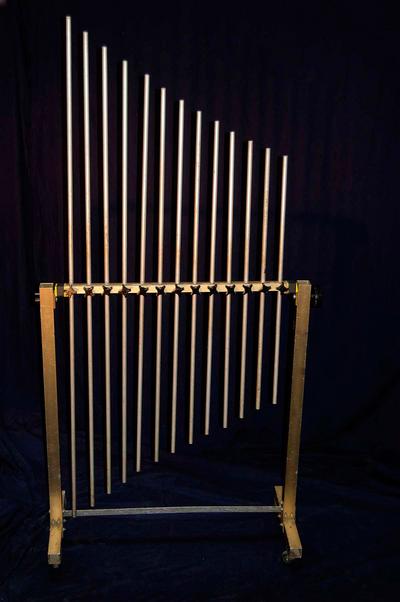Rub Rods, Round, Chromatically Tuned

(Aluminum Harp, Tuned Rub Rods, Singing Rods)
More complex sound. Played by pinching rods and sliding down. Gloves with rosin are used for friction. Vibrato can be made by waving hand up and down above rods.
Rub rods are sounded by using the friction of gripping between the fingers and pushing down or up on the rods. They are modeled after the J.C. Deagan Company’s “Aluminum Harp”. Both sets of rub rods (one with square tubes and one with round rods) are chromatic and one-octave in range.
Emil acquired them in the 1970s, when an aerospace industry worker from San Diego got in contact with him and came up to Los Angeles to show him these new instruments which he had fabricated. Although the craftsman had used powdered rosin on his fingers to create more friction on the rods, Emil decided to use bass bow rosin, as it was less messy and could be applied directly to the rods. Emil also wore gloves when playing, which helped produce the friction needed and avoid the stickiness of the rosin. Vibrato can be produced by shaking the hand above the rods after they have been sounded.
Overall, the round rods have more complicated overtones, while the square tubes produced a purer sound.
- Price/Day
- $120
- Range
- F6-F7

Rub rods underlay the reveal of the DeLorean in Back to the Future (1985) by Alan Silvestri.

In the main title music of Beetlejuice (1988), by Danny Elfman, the rub rods play a single note on the tonic at its conclusion.

Rub rods create a veil of sound in this mysterious clip from Flightplan (2005) by James Horner. You can especially hear their sustain between phrases.

Here’s an example of one of multiple times The Incredibles (2004) by Michael Giacchino uses rub rods in the score.

Emil Richards demonstrates rub rods on Jerry Goldsmith: Film Music Masters.

In Lethal Weapon (1987) by Michael Kamen, the rub rods play a sparse melodic role on top of other instruments and effects.

Listen for the high-pitched, sustaining rub rods in this clip from Lethal Weapon (1987) by Michael Kamen.

A single rub rod note arrives at the root near the completion of a cue from Mission: Impossible III (2006) by Michael Giacchino. Vibraphone with vibrato doubles underneath.

Rub rods play a prominent role in the beginning of this track from Poltergeist (1982) by Jerry Goldsmith.

In this excerpt from The Karate Kid (1984), composed by Bill Conti, high rub rods play a delicate role.